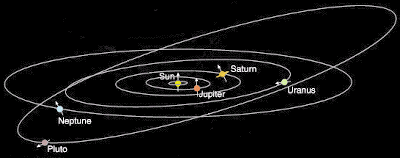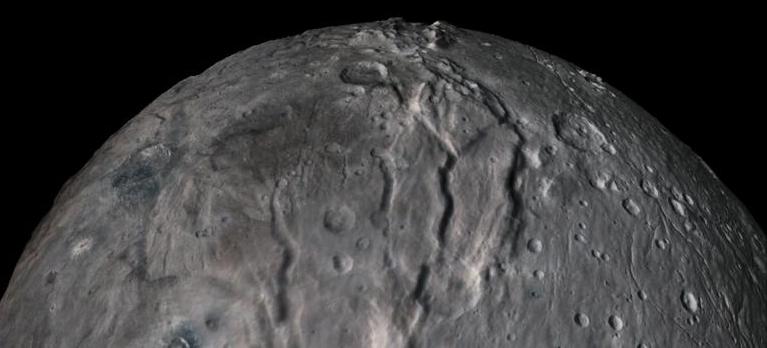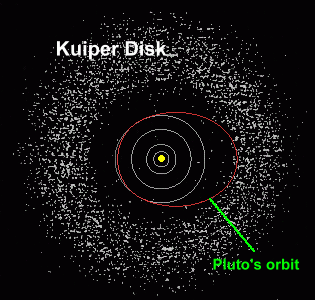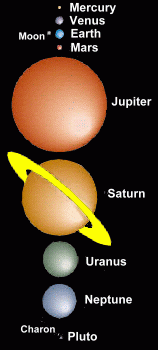
Pluto is the furthest planet from the sun, at a distance of 39.5 AU, or 6 billion km. It takes sunlight 5.5 hours to travel from the Sun to Pluto. Pluto has been visited by only one spacecraft. The Johns Hopkins University Applied Physics Laboratory designed, built, and operates the New Horizons spacecraft, which visited Pluto in 2015. By the time it reached the Pluto system, the spacecraft had traveled farther away and for a longer time period (more than nine years) than any previous deep space spacecraft ever launched. New Horizons accomplished its prime mission with a successful flyby of Pluto after a decade-long journey, traveling 5.25 billion kilometers across our solar system. New Horizons flew by Pluto and its five moons, Charon, Nix, Hydra, Kerberos and Styx, at a closest approach distance of 12,487 kilometers above Pluto's surface. Pluto is a dwarf planet in the Kuiper Belt, a donut-shaped region of icy bodies beyond the orbit of Neptune. There may be millions of these icy objects, collectively referred to as Kuiper Belt objects, or trans-Neptunian objects, in this distant region of our solar system. Pluto, which is smaller than Earth’s Moon, has a heart-shaped glacier that’s the size of Texas and Oklahoma. This fascinating world has blue skies, spinning moons, mountains as high as the Rockies, valleys, plains, craters, and maybe glaciers. And it snows ... but the snow is red. Pluto is only about 1,400 miles wide, or about half the width of the United States. It's about 3.6 billion miles away from the Sun, and it has a thin atmosphere composed mostly of nitrogen, methane, and carbon monoxide. On average, Pluto’s temperature is -232°C, making it too cold to sustain life.  Pluto is orbited by five known moons, the largest of which is Charon. Charon is about half the size of Pluto itself, making it the largest satellite relative to the planet it orbits in our solar system. Pluto and Charon are often referred to as a 'double planet.' The gravity on the surface of Pluto is about one fifteenth of what it is on Earth. By comparison, the force of gravity on Earth's Moon is a sixth of Earth's. Pluto has a very thin atmosphere, but it may exist as a gas only when Pluto is closest to the sun in its orbit.  Pluto's orbit is highly inclined to the plane of the solar system, and is very elongated. In fact, during its 248 year long orbit, Pluto actually gets closer to the sun than Neptune. It was inside Neptune's orbit from 1979 to 1999, but is now moved further out. The diagram at the right also indicates the rotational axis of each of the bodies. Note that Pluto, like Uranus, rotates 'on its side', compared to the sun and other planets. Its 'day' is just over 6 earth days long. Pluto's orbit is highly inclined to the plane of the solar system, and is very elongated. In fact, during its 248 year long orbit, Pluto actually gets closer to the sun than Neptune. It was inside Neptune's orbit from 1979 to 1999, but is now moved further out. The diagram at the right also indicates the rotational axis of each of the bodies. Note that Pluto, like Uranus, rotates 'on its side', compared to the sun and other planets. Its 'day' is just over 6 earth days long.
If you were to stand on the surface of Pluto at noon, the Sun would be 1/900 the brightness it is here on Earth. As mentioned above, Pluto's orbit around the Sun is unusual compared to most other planets: it's both elliptical and tilted. Pluto's 248-year-long, oval-shaped orbit can take it as far as 49.3 astronomical units from the Sun, and as close as 30 AU. (One AU is the mean distance between Earth and the Sun: about 150 million kilometers. Its axis of rotation is tilted 57 degrees with respect to the plane of its orbit around the Sun ... Earth's is 23 degrees ... so it spins almost on its side. Pluto also has retrograde rotation, spinning from east to west like Venus and Uranus. Pluto's largest moon Charon has an orbit around Pluto that takes 153 hours ... the same time it takes Pluto to complete one rotation. This means Charon neither rises nor sets in Pluto's sky, but hovers over the same spot on the surface. The same side of Charon always faces Pluto, a state called 'tidal locking'. Our own moon is tidally locked. The New Horizons spacecraft obtained some detailed photos of Charon.  Charon Pluto's five known moons, Charon, Nix, Hydra, Kerberos, and Styx, might have formed by a collision between Pluto and another similar-sized body early in the history of the solar system. Charon, the biggest , is about half the size of Pluto itself, and orbits Pluto at a distance of just 19,640 kilometers; for comparison, our moon is 20 times farther away from Earth. Pluto and Charon are often referred to as a double planet. The other moons are much smaller, less than 160 kilometers wide, and irregularly shaped. These moons are not tidally locked to Pluto. Pluto's tallest mountains are 2 to 3 kilometers in height. The mountains are big blocks of water ice, sometimes with a coating of frozen gases like methane. Long troughs and valleys as long as 600 kilometers line the surface in places. Craters as large as 260 kilometers in diameter exist, with some showing signs of erosion and filling. This suggests tectonic forces are slowly resurfacing Pluto. The most prominent plains observed on Pluto appear to be made of frozen nitrogen gas and show no craters. These plains instead show structures suggesting convection ... blobs of material circulating up and down.  An 80 km wide (top to bottom) photo of Pluto, taken from 17,000 km above the surface When Pluto is close to the Sun, its surface ices sublimate, changing directly from solid to gas), and rise to temporarily form a thin atmosphere. Pluto's low gravity, about 6% of Earth's, causes the atmosphere to be much more extended in altitude than Earth's. Pluto becomes much colder during the part of its lengthy year when it is traveling far away from the Sun. During this time, the bulk of the planet's atmosphere may freeze and fall as snow to the surface. |

